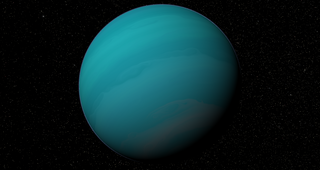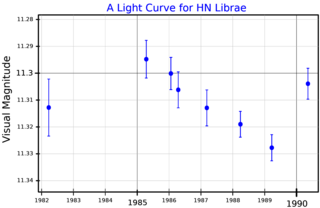
Gliese 876 is a red dwarf star 15.2 light-years away from Earth in the constellation of Aquarius. It is one of the closest known stars to the Sun confirmed to possess a planetary system with more than two planets, after GJ 1061, YZ Ceti, Tau Ceti, and Wolf 1061; as of 2018, four extrasolar planets have been found to orbit the star. The planetary system is also notable for the orbital properties of its planets. It is the only known system of orbital companions to exhibit a near-triple conjunction in the rare phenomenon of Laplace resonance. It is also the first extrasolar system around a normal star with measured coplanarity. While planets b and c are located in the system's habitable zone, they are giant planets believed to be analogous to Jupiter.

Gliese 436 is a red dwarf located 31.9 light-years away in the zodiac constellation of Leo. It has an apparent visual magnitude of 10.67, which is much too faint to be seen with the naked eye. However, it can be viewed with even a modest telescope of 2.4 in (6 cm) aperture. In 2004, the existence of an extrasolar planet, Gliese 436 b, was verified as orbiting the star. This planet was later discovered to transit its host star.
Gliese 581 is a red dwarf star of spectral type M3V which hosts a planetary system, 20.5 light-years away from Earth in the Libra constellation. Its estimated mass is about a third of that of the Sun, and it is the 101st closest known star system to the Sun. Gliese 581 is one of the oldest, least active M dwarfs known. Its low stellar activity improves the likelihood of its planets retaining significant atmospheres, and lessens the sterilizing impact of stellar flares.

Gliese 876 b is an exoplanet orbiting the red dwarf Gliese 876. It completes one orbit in approximately 61 days. Discovered in June 1998, Gliese 876 b was the first planet to be discovered orbiting a red dwarf.

Gliese 436 b is a Neptune-sized exoplanet orbiting the red dwarf Gliese 436. It was the first hot Neptune discovered with certainty and was among the smallest-known transiting planets in mass and radius, until the much smaller Kepler exoplanet discoveries began circa 2010.

Gliese 581c is an exoplanet orbiting within the Gliese 581 system. It is the second planet discovered in the system and the third in order from the star. With a mass about 6.8 times that of the Earth, it is classified as a super-Earth.

Gliese 581d is a doubtful, and frequently disputed, exoplanet candidate orbiting within the Gliese 581 system, approximately 20.4 light-years away in the Libra constellation. It was the third planet claimed in the system and the fourth or fifth in order from the star. Multiple subsequent studies found that the planetary signal in fact originates from stellar activity, and thus the planet does not exist, but this remains disputed.

A Super-Earth is a type of exoplanet with a mass higher than Earth's, but substantially below those of the Solar System's ice giants, Uranus and Neptune, which are 14.5 and 17 times Earth's, respectively. The term "super-Earth" refers only to the mass of the planet, and so does not imply anything about the surface conditions or habitability. The alternative term "gas dwarfs" may be more accurate for those at the higher end of the mass scale, although "mini-Neptunes" is a more common term.
Gliese 176 is a small star with an orbiting exoplanet in the constellation of Taurus. With an apparent visual magnitude of 9.95, it is too faint to be visible to the naked eye. It is located at a distance of 30.9 light years based on parallax measurements, and is drifting further away with a heliocentric radial velocity of 26.4 km/s.
Gliese 832 b is a gas giant exoplanet about 80% the mass of Jupiter, located 16.2 light-years from the Sun in the constellation of Grus, orbiting the red dwarf star Gliese 832.

Gliese 581e or Gl 581e is an exoplanet orbiting within the Gliese 581 system, located 20.5 light-years away from Earth in the Libra constellation. It is the third planet discovered in the system and the first in order from the star.
Gliese 433 is a dim red dwarf star with multiple exoplanetary companions, located in the equatorial constellation of Hydra. The system is located at a distance of 29.6 light-years from the Sun based on parallax measurements, and it is receding with a radial velocity of +18 km/s. Based on its motion through space, this is an old disk star. It is too faint to be viewed with the naked eye, having an apparent visual magnitude of 9.81 and an absolute magnitude of 10.07.

An exoplanet is a planet located outside the Solar System. The first evidence of an exoplanet was noted as early as 1917, but was not recognized as such until 2016; no planet discovery has yet come from that evidence. What turned out to be the first detection of an exoplanet was published among a list of possible candidates in 1988, though not confirmed until 2003. The first confirmed detection came in 1992, with the discovery of terrestrial-mass planets orbiting the pulsar PSR B1257+12. The first confirmation of an exoplanet orbiting a main-sequence star was made in 1995, when a giant planet was found in a four-day orbit around the nearby star 51 Pegasi. Some exoplanets have been imaged directly by telescopes, but the vast majority have been detected through indirect methods, such as the transit method and the radial-velocity method. As of 1 July 2024, there are 6,660 confirmed exoplanets in 4,868 planetary systems, with 995 systems having more than one planet. This is a list of the most notable discoveries.
Gliese 180, is a small red dwarf star in the equatorial constellation of Eridanus. It is invisible to the naked eye with an apparent visual magnitude of 10.9. The star is located at a distance of 39 light years from the Sun based on parallax, and is drifting closer with a radial velocity of −14.6 km/s. It has a high proper motion, traversing the sky at the rate of 0.765 arcseconds per year.
Gliese 15 Ab, also commonly called Groombridge 34 Ab, rarely called GX Andromedae b is an extrasolar planet approximately 11 light-years away in the constellation of Andromeda. It is found in the night sky orbiting the star Gliese 15 A, which is at right ascension 00h 18m 22.89s and declination +44° 01′ 22.6″.

Gliese 555 is a small star with one or more orbiting exoplanets in the constellation Libra. It has the variable star designation HN Librae, abbreviated HN Lib. With an apparent visual magnitude of 11.32, it can only be viewed through a telescope. The system is located at a distance of 20.4 light years based on parallax measurements, but is drifting closer to the Sun with a radial velocity of −1.4 km/s. It does not appear to belong to any known stellar moving group or association.
Luyten b is a confirmed exoplanet, likely rocky, orbiting within the habitable zone of the nearby red dwarf Luyten's Star. It is the fourth-closest potentially habitable exoplanet known, at a distance of 12 light-years. Only Proxima Centauri b, Ross 128 b, and GJ 1061 d are closer. Discovered alongside Gliese 273c in June 2017, Luyten b is a super-Earth of around 2.89 times the mass of Earth and receives only 6% more starlight than Earth, making it one of the best candidates for habitability.











